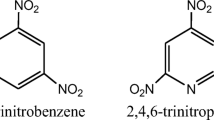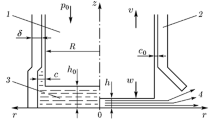Abstract
Shock sensitivity analysis of explosives was performed for 53 polynitroaliphatic compounds within the framework of the proposed model. The fifty-percent relative frequency was used as the numerical characteristic of the sensitivity. Its values were determined using the mean resonance energy calculated in the CNDO/2 approximation and two individual calculated molecular descriptors. Good agreement between the theory and experiment is observed.
Similar content being viewed by others
References
B. V. Litvinov, A. A. Fainzil'berg, V. I. Pepekin, et al., “Increasing the effectiveness of High-energy chemical substances: high-energy compounds containing active fluorine and active oxygen in molecule,”Dokl. Ross. Akad. Nauk,336, No. 1, 67–68 (1994).
A. V. Belik, and V. A. Potemkin, “Prediction of the shock sensitivity of explosives,”Fiz. Goreniya Vzryva,24, No. 5, 103–106 (1988).
É. A. Petrov, I. S. Popov, and V. G. Kuznetsov, “Empirical relationship between the sensitivity of individual secondary explosives and their chemical structure,”Fiz. Goreniya Vzryva,26, No. 4, 109–110 (1990).
É. A. Petrov and L. T. Eremenko, “The effect of supermolecular structure of high explosives on their sensitivity,”Fiz. Goreniya Vzryva,27, No. 3, 80–82 (1991).
N. S. Enikolopyan, L. V. Larionov, P. P. Babenko, et al., “Effect of intermolecular interaction on the sensitivity of liquid explosives,”Dokl. Akad. Nauk SSSR,320, No. 1, 148–150 (1991).
D. V. Sukhachev, “Development of a new method of searching for “structure-property” correlations and prediction of parameters of energetic compounds,” Doct. Dissertation in Phys.-Math. Sci., Tver' (1993).
M. V. Lisanov and A. V. Dubovik, “Generalized index of sensitivity to mechanical actions for viscous-flow, pasty, and solid explosives,” in:Xth Symp. on Combustion and Explosion. Detonation [in Russian], Chernogolovka (1992), pp. 60–62.
M. Kamlet, “Relationship between the shock sensitivity and structure of polynitroaliphatic organic explosives,” in:Detonation and Explosives [Russian translation], Mir, Moscow (1981), pp. 142–159.
L. G. Strakovskii, “Relationship between the combustibility of solid explosives and their sensitivity to shock and impact,”Fiz. Goreniya Vzryva,26, No. 1, 125–129 (1990).
M. Yu. Dolomatov and Yu. G. Kamenir, “Thermodynamic stability and identification of characteristic spectra of organic matter,”Zh. Mendeleev Khim. Obshch.,36, No. 3, 384 (1991).
A. V. Belik, V. A. Potemkin, and N. S. Zefirov, “Relationship between the geometric structure of explosive molecules and shock sensitivity,”Dokl. Akad. Nauk SSSR,308, No. 4, 882–886 (1989).
N. S. Enikolopyan, “Detonation as a solid-state chemical reaction,”Dokl. Akad. Nauk SSSR,302, No. 3, 630–634 (1988).
N. S. Enikolopyan, “Superfast chemical reactions in solids,”Zh. Fiz. Khim.,63, No. 9, 2289–2298 (1989).
A. A. Khzardzhyan, V. B. Vol'eva, A. Yu. Karmilov, et al., “Nonthermoactivation mechanism of solid-state chemical reactions,”Dokl. Akad. Nauk SSSR,314, No. 2, 410–412 (1990).
S. M. Ryabykh, V. V. Barelko, and K. Sh. Karabukaev, “Nonthermal initiation of lead and silver azides by an electronic pulse,” in:Xth Symp. on Combustion and Explosion. Detonation [in Russian], Chernogolovka (1992), pp. 78–80.
S. M. Ryabykh, V. V. Barelko, and K. Sh. Karabukaev, “Possibility of gasless detonation of lead and silver azides,”ibid., in:Xth Symp. on Combustion and Explosion. Detonation [in Russian], Chernogolovka (1992), pp. 27–29.
F. I. Ivanov, “Electric nature of ‘hot spots’ for initiation of detonation of lead azide,”ibid., in:Xth Symp. on Combustion and Explosion. Detonation [in Russian], Chernogolovka (1992), pp. 64–66.
T. N. Iskhakov, A. V. Aleksandrov, and V. F. Lyudvigov, “Effect of an electric field on the shock sensitivity of high explosives,”ibid., in:Xth Symp. on Combustion and Explosion. Detonation [in Russian], Chernogolovka (1992), pp. 70–71.
A. V. Belik, R. Z. Zakharyan, and V. A. Shlyapochnikov, “Electronic structure of molecules of nitrocompounds,”Izv. Akad. Nauk SSSR, Ser. Khim., No. 8, 1714–1719 (1976).
A. V. Belik, S. K. Bakeeva, and V. A. Shlyapochnikov, “Electronic structure of hydrazines and nitramines,”Izv. Akad. Nauk SSSR., Ser. Khim., No. 11, 2608–2610 (1977).
J. A. Pople and D. L. Beveridge,Approximate Molecular Orbital Theory, Mcgraw-Hill, New York (1970).
H. Ficher and H. Kollmar, “Energy partitioning with the CNDO method,”Theor. Chim. Acta (Berl.),16, 163–174 (1970).
V. A. Potemkin and A. V. Belik, “Calculation model for the shock sensitivity of explosives,” in:Xth Symp. on Combustion and Explosion. Detonation [in Russian], Chernogolovka (1992), pp. 62–63.
L. S. Mayants,Theory and Calculation of Oscillations of Molecules [in Russian], Izd. Akad. Nauk SSSR, Moscow (1960).
L. D. Landau and E. M. Livshits,Mechanics. Electrodynamics [in Russian], Nauka, Moscow (1969).
A. V. Belik and V. A. Potemkin, “New interpretation of a number of geometric indices,”Dokl. Akad. Nauk SSSR,312, No. 2, 377–379 (1990).
A. V. Belik and V. A. Potemkin, “New method for prediction of the shock sensitivity of explosives,”Fiz. Goreniya Vzryva,28, No. 1, 115–116 (1992).
Author information
Authors and Affiliations
Additional information
Translated fromFizika Goreniya i Vzryva, Vol. 35, No. 5, pp. 107–112, September–October 1999.
Rights and permissions
About this article
Cite this article
Belik, A.V., Potemkin, V.A. & Sluka, S.N. Shock sensitivity analysis of organic explosives. Combust Explos Shock Waves 35, 562–567 (1999). https://doi.org/10.1007/BF02674502
Received:
Revised:
Issue Date:
DOI: https://doi.org/10.1007/BF02674502




